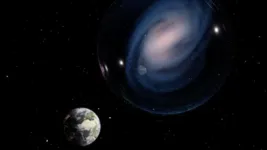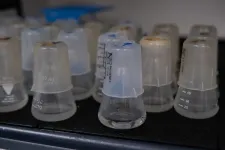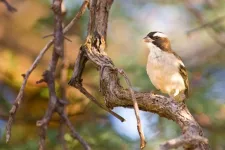A binational team of scientists, using creativity and innovation, adorned dozens of endangered thick-billed parrots with tiny solar-powered satellite transmitters to track and reveal their winter migratory nesting sites in the remote treetops of the Sierra Madre Occidental ranges. Their research reveals new critical habitat, 80% of which has no formal protection.
In a study published this month in the journal Global Ecology & Conservation, researchers from San Diego Zoo Wildlife Alliance and Organización Vida Silvestre A.C. (OVIS) in Mexico were able to track the birds that soar high above the rugged pine forests of Mexico, terrain too difficult for researchers to follow. The research was led by James Sheppard, Ph.D., and SDZWA Recovery Ecology Senior Scientist.
“Until now, it was a mystery where thick-billed parrots overwinter and the sites where they nest along the way, creating a difficult challenge for efforts to conserve this species,” Sheppard said. “We have now identified new, critical habitat and migratory routes for thick-billed parrots as well as steps that need to be taken to protect them.”
The charismatic thick-billed parrot, the only living parrot species native to the United States, once thrived in parts of Arizona and New Mexico in the U.S., south to Venezuela. Due to habitat loss, illegal hunting and predation, an estimated less than 2,000 thick-billed parrots remain in the wild, and only in the pine forests of Mexico.
“Prior to this study, there was only anecdotal evidence to suggest where thick-billed parrots spent their breeding and overwintering seasons,” said Ernesto Enkerlin-Hoeflich, OVIS Director for Science. “Now we can show the birds spend their breeding season mostly in the states of Chihuahua and northern Durango then overwinter in the south-central Sierra Madres, and we can share this information with regulatory agencies and engage them and the conservation community to protect the forests the parrots need to survive.”
The study shows parrots require old-growth forests comprised of mature pine trees that provide nesting hollows and pine nuts for food. Less than 1% of the old-growth forest that once covered the Sierra Madre Occidental remains, Sheppard said.
“Strikingly, less than 20% of the newly identified thick-billed parrot overwintering habitat is protected from the timber industry and common clear-cutting practices,” Sheppard said. “Further, existing networks of protected sites may not be adequate for the parrots’ survival as a changing climate increases the intensity and frequency of forest fires as well as exacerbated pine beetle outbreaks, which can devastate a previously healthy forest. The good news is, we understand what’s needed to save this iconic bird.”
Data collected was the result of a three-year effort that started after Sheppard convinced a technology company to sell SDZWA the supplies that the team used to construct the silver-dollar sized transmitters or “backpacks.”
“They weren’t going to sell us the technology because they didn’t think it was possible to attach GPS transmitters to these strong, boisterous birds,” Sheppard said. “But we convinced them and proved it could be done.”
Since first attaching the solar-powered transmitters, researchers have acquired a dataset of more than 40,000 locations remotely from the tracked parrots, enabling the discovery of a new nesting location as well as their overwintering home ranges, migration paths and stopover sites.
“Now, with the sustained engagement of local stakeholders, we hope to successfully recover wild populations of thick-billed parrots as well as old-growth forests, and perhaps one day, use this information to reintroduce thick-billed parrots to their former ranges, including in the U.S.,” Sheppard said.
###
About San Diego Zoo Wildlife Alliance
San Diego Zoo Wildlife Alliance, a nonprofit conservation leader, inspires passion for nature and collaboration for a healthier world. The Alliance supports innovative conservation science through global partnerships. Through wildlife care, science expertise and collaboration, more than 44 endangered species have been reintroduced to native habitats. Annually, the Alliance reaches over 1 billion people, in person at the San Diego Zoo and San Diego Zoo Safari Park, and virtually in 150 countries through media channels, including San Diego Zoo Wildlife Explorers television programming in children’s hospitals in 13 countries. Wildlife Allies—members, donors and guests—make success possible.
DOWNLOAD PHOTOS AND VIDEO: https://sandiegozoo.box.com/s/x50kzaoukdtyjxsv9mzqgn0fu1m6kddk
Link includes:
Photos and B-Roll of thick-billed parrot research being conducted in the Sierra Madre Occidental, including fitting wild parrots with satellite transmitters
PERMITTED USE: Images and video(s) are provided to the media solely for reproduction, public display, and distribution in a professional journalistic non-commercial and non-sponsored context in connection with newspaper, magazine, broadcast media (radio, television) or internet media (ad enabled blog, webcasts, webinars, podcasts). Image(s) and video(s) may not be made available for public or commercial download, licensing or sale.
ADDITIONAL LIMITATION: Media acknowledges and agrees that San Diego Zoo Wildlife Alliance specifically does not grant a right to sublicense any image and/or video without the prior express written consent of San Diego Zoo Wildlife Alliance in each instance and at its sole discretion.
REQUIRED CREDIT AND CAPTION: All image and/or video uses must bear the copyright notice and/or be properly credited to the relevant photographer, as shown in the image metadata, and must be accompanied by a caption that makes reference to the San Diego Zoo and/or San Diego Zoo Safari Park. Any uses in which the image and/or video appears without proper copyright notice, photographer credit and a caption referencing the San Diego Zoo, San Diego Zoo Safari Park, and/or San Diego Zoo Wildlife Alliance are subject to paid licensing.
AP PERMITTED USE: Specific to the Associated Press (“AP”) only, San Diego Zoo Wildlife Alliance has provided to the AP one or more photograph(s) and/or video(s) for distribution by the AP to its subscribers and customers solely for editorial publication. San Diego Zoo Wildlife Alliance is the sole copyright owner of the photograph(s) and/or video(s) furnished to AP for editorial publication by AP and its subscribers and customers in all media now known or hereafter created. Said content is a factually accurate rendering of what it depicts and has not been modified or augmented except for standard cropping and toning.
END




